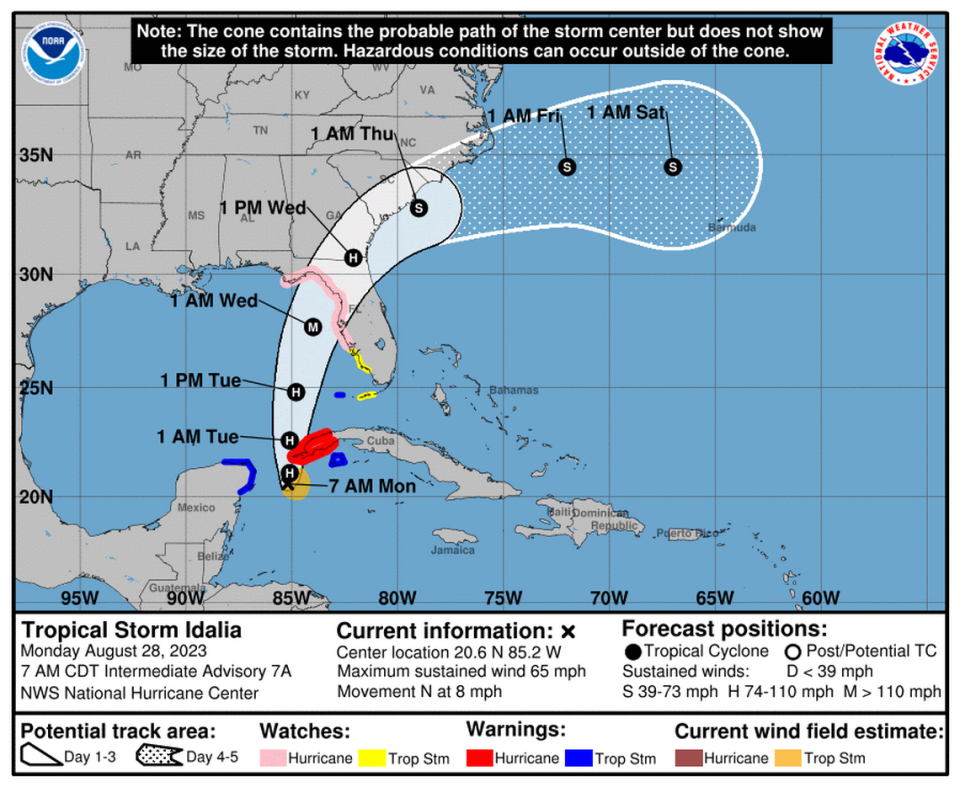Here’s how to prepare in SC as Hurricane Idalia moves closer to the state
Are you ready for Tropical Storm Idalia?
Idalia strengthen to a hurricane early Tuesday morning as it heads to the Florida coast, according to the National Weather Service Hurricane Center. Current models has the storm reaching South Carolina around early Thursday.

According to the South Carolina Emergency Management Division, South Carolina is one of the most vulnerable states to hurricanes and tropical storms all throughout the season, which lasts until Nov. 30.
Six coastal counties border the Atlantic Ocean. These counties have more than 200 miles of general coastline and another 21 inland counties may be directly affected by these storms. Densely populated coastal areas, especially during peak tourist seasons, coupled with the generally low coastal elevations significantly increase the state’s vulnerability.
South Carolina is expected to have an above-normal hurricane season for the remainder of the year, according to the National Oceanic and Atmospheric Administration. The latest forecast, which includes the entire hurricane season that lasts from June through November, calls for 14-21 named storms (winds of 39 mph or greater), of which six to 11 could become hurricanes (winds of 74 mph or greater). And of those, two to five could become major hurricanes (winds of 111 mph or greater). These updates include storms that have already formed this season.
Last year the Atlantic hurricane season had 14 named storms. The 2022 season included Hurricane Ian, which, after plowing through Florida, landed around Georgetown, S.C. in September. The storm had sustained winds of 85 mph, caused coastal flood damage and destroyed several large piers near Myrtle Beach.
Here are five ways to prepare for the 2023 hurricane season, according to the SCEMD.
Know your zone in South Carolina
State and local officials issue hurricane evacuations based on zones in coastal counties. Know your hurricane evacuation zone instantly with the SC Emergency Manager mobile app and Hurricane.sc, South Carolina’s online hurricane guide.
Prepare your home
Do a safety check to make sure your home is best able to withstand the effects of a hurricane. Have your roof inspected, double check hurricane shutters and make sure your insurance policies cover the types of damages hurricanes can cause. Make a list and take photos of your belongings as records.
Have a family emergency plan
Emergency responders across the state encourage residents to create a family emergency plan in the event of a hurricane, which should include an evacuation destination and agreed-upon meeting locations. In addition, residents should keep phones charged when possible and maintain a way to find out the latest information on storms and impacts to their home area. SCEMD’s Hurricane Guide provides more safety and planning recommendations.
Remember your evacuation route
Be aware of the closest hurricane evacuation route ahead. This will allow for a more efficient and safer route out of the area if a hurricane is heading your way. Once you’ve learned your route, stick with it and remember it. Rely on the blue hurricane evacuation signs, not GPS. To review hurricane routes, review the state’s hurricane guide.
Hurricanes and tropical storms not only threaten the coast, but all areas of South Carolina. Storm surge and flooding are the most deadly and destructive hazards associated with tropical storms and hurricanes. High winds and tornadoes can cause severe damage to buildings and homes.
Have multiple hurricane alert options
Your family should have multiple ways to receive emergency alerts that can tell you what’s happening and what you need to do. Those include wireless emergency alerts on mobile devices, NOAA weather radios and local broadcast TV or radio. Do not rely on just one way to get emergency information.
For additional public safety notifications, sign up for CodeRED alerts. You can select what types of alerts to receive and by what method, including text message, voice phone call or email.
Register for CodeRED alerts for free through the SCEMD website by visiting scemd.org.


